![]() German soldiers in a trench in France
German soldiers in a trench in France
ADOLF HITLER AND ERICH MARIA REMARQUE FIGHTING TOGETHER
This is the untold story of two young German soldiers fighting on the same time, on the same front, maybe even in the same trench. Both experience the war as a nightmare. Both become seriously wounded. Both are fond of dogs. But here the resemblance stop. When the Great War is over, one of them becomes the greatest pacifist writer of the century. The other one ends up as the most atrocious war-criminal of the century.
Extremes in No Man's Land
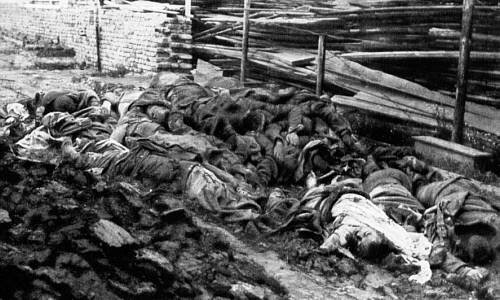 The British didn't like mass graves, but near the village of Fromelles, on the Somme front, they had to make one. In July 1916, in a few days time, thousands of British and Australian soldiers were literally torn apart. From what was left of them no one was able to put together individual corpses.
The British didn't like mass graves, but near the village of Fromelles, on the Somme front, they had to make one. In July 1916, in a few days time, thousands of British and Australian soldiers were literally torn apart. From what was left of them no one was able to put together individual corpses.
The German picture on the right was made during the battle in streets of Fromelles.
The Germans were having a hard time too. In the night of July 14th the allies were able to cut off German communication on the frontline. A British direct hit rendered all German field-telephones worthless. From that moment on the Germans had to send their messages by Meldegänger, orderlies.
These postman-soldiers were running from post to post, "in the eye of an almost certain death and pelted by shell-fire on every meter of the road", as a 27 years old German orderly, by the name of Adolf, later writes in a letter.
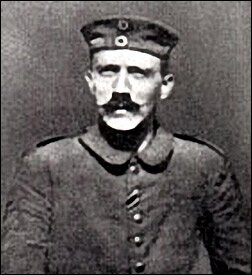 Every day this young German sprints through the trenches. When a screaming noise announces a shell he ducks into shell-holes and ditches. Another exhausted orderly collapses on his way through the first lines. Adolf grabs him and drags him back to an underground shelter. This gets him an badge — not his first one: he carries already the Iron Cross Second Class for 'personal courage'.
Every day this young German sprints through the trenches. When a screaming noise announces a shell he ducks into shell-holes and ditches. Another exhausted orderly collapses on his way through the first lines. Adolf grabs him and drags him back to an underground shelter. This gets him an badge — not his first one: he carries already the Iron Cross Second Class for 'personal courage'.
For whatever you may say about Adolf Hitler (picture on the left) — he was not afraid and not easily scared. All soldiers who served with him in the trenches of the Somme, and later in Flanders, have testified to that.
Miraculous
Adolf has few friends on the Western Front. That is not only due to his unpleasant character. Almost all his friends die in action — while Adolf again and again miraculously escapes from death.
After the war he told G. Ward Price, an English reporter, how once he was eating his dinner with his comrades in a trench. "Suddenly a voice seemed to be saying to me, 'Get up and go over there.' It was so clear and insistent that I obeyed automatically, as if it had been a military order. I rose at once to my feet and walked twenty yards along the trench, carrying my dinner in its tin can with me. Then I sat down to go on eating, my mind being once more at rest. Hardly had I done so when a flash and deafening report came from the part of the trench I had just left. A stray shell had burst over the group in which I had been sitting, and every member of it was killed."
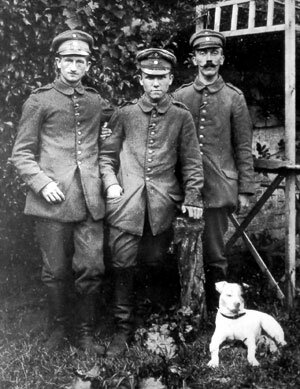 From all his friends finally only Fuchsl, little fox, remains. The small white terrier, apparently the mascot of English soldiers, had been chasing a rat in No Man's Land. The dog had jumped into a German trench, where Adolf had catched him — and kept him.
From all his friends finally only Fuchsl, little fox, remains. The small white terrier, apparently the mascot of English soldiers, had been chasing a rat in No Man's Land. The dog had jumped into a German trench, where Adolf had catched him — and kept him.
From that moment on Fuchsl never leaves Adolfs side. "I can look at him like I look at a human being", he writes. When the orderly takes his diner the dog sits beside him. "I am crazy about him."
Hitler and two of his front-comrades have their photograph taken. Adolf insists on having Fuchsl at his feet. See the picture on the right.
In October 1916 Adolf runs out of luck. The massacre at the Somme is still going on. The allies keep on attacking. In three months time they have lost 600,000 men: completely in vain, because the German lines hold.
In the night of October 7th Hitler sleeps in a new tunnel that runs to the regimental headquarters. A British shell hits and Adolf gets a fragment in a leg. "How bad is it? I don't have to go, have I?", he anxiously asks his lieutenant. But after a glance at the soldiers leg, the lieutenant orders a hospital-orderly to carry Hitler away.
Enrolled
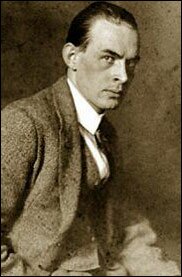 Now the second leading character of this account comes into focus. At the same time Adolf disappears for five months into an hospital at Berlin, a young German enrolls in the army. His name is Erich Paul Remark 1) (the picture on the left shows him at the age of 25).
Now the second leading character of this account comes into focus. At the same time Adolf disappears for five months into an hospital at Berlin, a young German enrolls in the army. His name is Erich Paul Remark 1) (the picture on the left shows him at the age of 25).
Remark is the son of a poor book-binder and in the years to come he will cross Adolfs path a couple of times. And he will become famous under the name of his great-grandfather — a name he will take on when the Great War is over: Remarque.
Erich loves music and wants to become composer. He is conscripted into the army. He does not report voluntary, as readers of All Quiet on the Western Front might think. And neither he, nor his school class, were incited to enlist by a bellicose teacher.
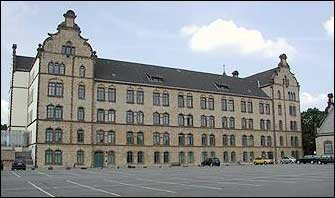 He is not 17 years old, as he would later use to say in interviews, but almost 19 years old. But he does not mind his conscription, on the contrary, he is enthusiast, he feels a real German patriot. "We are going to save the world", he tells his friends.
He is not 17 years old, as he would later use to say in interviews, but almost 19 years old. But he does not mind his conscription, on the contrary, he is enthusiast, he feels a real German patriot. "We are going to save the world", he tells his friends.
In the Caprivi-barracks (picture on the right), near his birthplace Osnabrück, the army teaches him to shoot and how to handle a bayonet. It is spring 1917, the boys want to go to the front, but they will have to wait until June.
On the 1st of March 1917 orderly Hitler, recovered from his wound, returns to the Somme-front. Both sides are so exhausted by the battle that a kind of pause has set in. Again Adolf runs with dispatches through the trenches. On March 9th he gets a new decoration for extraordinary bravery. But his rank is still Gefreiter, something between a corporal and soldier first class.
According to his lieutenant, Fritz Wiedemann 2) , Adolf is a fine orderly, but he misses ' leadership qualities'. Hitler often looks nonchalant, he keeps his head a bit crooked and his shoes are seldom polished. He does not click his heels when an officer passes by. Promotion is not an option.
To Ypres
June 1917. Hitlers regiment is moved fifty kilometers to the north, to Belgium, near the besieged city of Ypres. The Germans have gotten word that the allies are preparing a new offensive here.
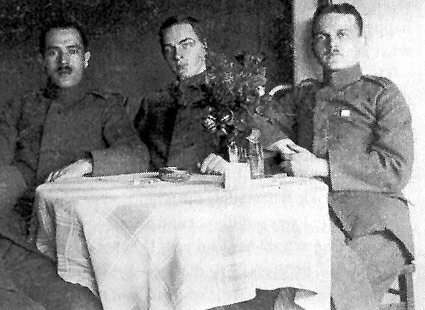 That's why the regiment of the quite fresh soldier Erich Paul Remark is send to that region too. Adolf and Erich don't know each other then, but they serve close together. There are only a few miles between Remark's 15th Regiment of the 2nd Guard Reserve Division and Hitler's 16th Regiment of the 10th Bavarian Division.
That's why the regiment of the quite fresh soldier Erich Paul Remark is send to that region too. Adolf and Erich don't know each other then, but they serve close together. There are only a few miles between Remark's 15th Regiment of the 2nd Guard Reserve Division and Hitler's 16th Regiment of the 10th Bavarian Division.
On June 17th Remark faces the frontline for the first time. He is sapper. At nights he has to build barbed wire entanglements in No Man's Land — a dangerous job. Very soon his friend Christian Kranzbühler is hit by a shell. Under a British barrage Remark drags him back to the German lines. On this picture Christian is seen on the left. Remark sits in the middle.
Christian has to spare a leg. In All Quiet on the Western Front Remarque gives him the name Franz Kemmerich and lets him die in the hospital (after which Kemmerichs beautiful boots go over to the next soldier in their group). In reality Christian stays alive and will cause Erich lots of trouble later.
Whatever enthusiasm for the war was left completely disappears here at the Ypres-front. Erich watches a shell hitting another friend. "I saw him lying in the mud, with his belly torn open. Such a sight is not comprehendible. And also not comprehendible is that is takes so many years before the full terror really gets to you", he will say later.
Indeed — much later — in All Quiet on the Western Front (that came out in 1929) and in almost any other book Remarque writes about the war, there are scenes with soldiers or animals with bowels bulging out of their belly. As if only then, many years after, the full terror really got to him.
Abhorrent
This Third Battle of Ypres, better known as the Battle of Passchendale, in which Remark and Hitler both fight, becomes an abhorrence beyond description with gas, tanks — and incessant rain.
After hundred days of fighting in the Flemish mud the allies have advanced 8 kilometers, little more than 5 miles. Five hundred thousand young men on both sides are either dead or wounded.
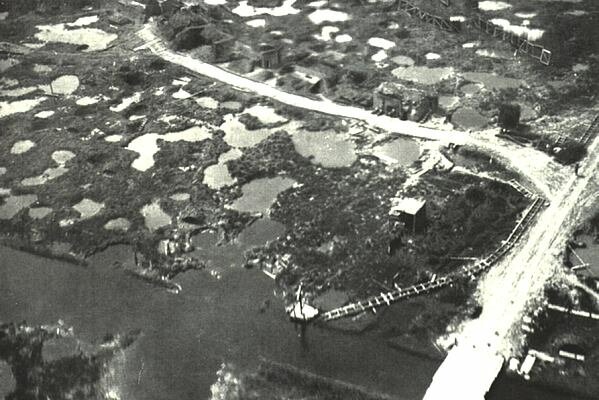 The battle started on the last day of July — the allies attack with all they have. And again Gefreiter Hitler rushes through the German trenches. He carries dispatches with orders to hold out, regardless of losses. Again he appears to be invulnerable. A soldier says to him: 'Mensch, für dich gibt es keine Kugel", for you there is no bullet.
The battle started on the last day of July — the allies attack with all they have. And again Gefreiter Hitler rushes through the German trenches. He carries dispatches with orders to hold out, regardless of losses. Again he appears to be invulnerable. A soldier says to him: 'Mensch, für dich gibt es keine Kugel", for you there is no bullet.
On that 31st of July British soldiers advance to the village of Langemark — and are driven back. Scottish soldiers conquer Frezenberg (a part of Zonnebeke) — and are driven back. Other British troops capture the village of Westhoek (near Zonnebeke) — and are driven back.
Remark's unit is fighting near the Totenmuhle, the Deathmill, close to the village of St. Juliaan (St Julien) and on the road towards Zonnebeke (aerial picture). Remark gets hit by an exploding British shell. One of the splinters penetrates his right forearm — the end of his dreamed career in music.
A second shell fragment hits his left leg, just above the knee. But the most serious is the third fragment: in his neck. Remark is carried away and a few days later he is transported to the St. Vincentius army hospital in Duisburg, Germany.
Surgeons succeed in removing the steel fragments from his body. Then he is brought to a convalescent home on the mountain Klosterberg in Osnabrück. Here he will be nursed for fourteen months — until the war is nearly over.
Deadly serious
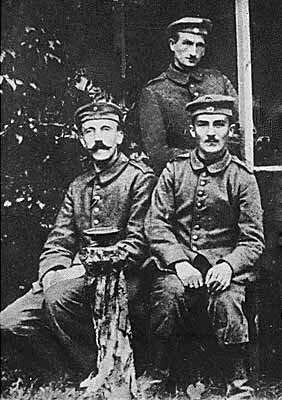 On the Ypres front Adolf (picture: the soldier on the left) is still doing his utmost best. One of his fellow soldiers later told that Hitler in this period became less and less liked: "He was always deadly serious. He never laughed, he never made jokes".
On the Ypres front Adolf (picture: the soldier on the left) is still doing his utmost best. One of his fellow soldiers later told that Hitler in this period became less and less liked: "He was always deadly serious. He never laughed, he never made jokes".
When the other soldiers complain about the war, Adolf rants on about patriotism and the responsibilities of a soldier. "We all cursed him, he was a real pain", a former comrade told.
In August 1917 Adolfs battered regiment is relieved. They have to go by train to the Alsace. On the station a railway employee, delighted with the capers of Fuchsl, offers Hitler 200 Marks for the terrier. "Even if you gave me 200.000 Marks, I don't sell him", Hitler answers.
But when the troops arrive at their destination and leave the train, Fuchsl is nowhere to be found. "I was desperate. The pig that had stolen my doggie didn't know what he was doing to me."
In those same days another 'pig' pinches Hitlers rucksack with drawings and paintings of the war. Later this will be a reason for many a myth about the superb, but alas, lost, painting art by Hitler.
Spring-offensive
In spring 1918 Germany undertakes it last desperate offensive. Remark is still being nursed in Osnabrück, but Hitler pulls his weight again. On one of his postal rounds in the trenches near Soissons in France he spots something that looks like a French helmet.
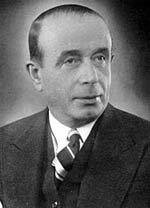 Hitler sneaks forward and sees four French soldiers. He draws his pistol and starts shouting at them, in German. The four Frenchmen, as worn out by the war as any other soldiers, immediately surrender.
Hitler sneaks forward and sees four French soldiers. He draws his pistol and starts shouting at them, in German. The four Frenchmen, as worn out by the war as any other soldiers, immediately surrender.
For this achievement Adolf receives on August 4th — for "personal bravery and general merits" — the Iron Cross First Class. This is an unusual decoration for a common Gefreiter. The rest of his life he will wear the medal.
The officer who recommended him for this honor was captain Hugo Guttman 3), a Jew (picture on the left). The rest of his life Hitler will keep silent about him.
Back in Belgium
In October 1918, when in Osnabrück the recovered soldier Erich Remark prepares himself to return to the front in Belgium, Adolf Hitler is there too again.
Southeast of the city of Ypres lies the small village of Wervik. On October 14th British shells tear the ground open. Between the screams of the shells the German soldiers hear muffled bangs: exploding musterdgas shells. For the first time the Germans get a taste of their own specific medicine.
Adolf is hiding in one of the trenches in Wervik. Just like his fellow-soldiers he wears a gas mask, that protects against the gas. The bombardment goes on and on — the whole day and the whole night.
Suddenly one of the recruits next to him becomes raving mad because of fear and anxiety; he tears his gas mask away — and swallows the deadly toxic cloud. The boy dies gasping and hawking. His comrades can only look on.
At first light the barrage stops. After a while Adolf and his fellow-soldiers take their gas masks off and take deep breath from the fresh morning air. Plock, plock — a British gun fires one last round of gas shells. The German soldiers panic: some of them can't get to their mask fast enough and die. The others become half or fully blind.
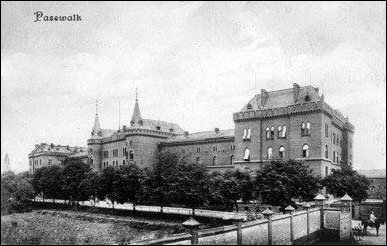 One of them is still able to see. He tells the others to grab each others coat, then he will try to bring them in safety.
One of them is still able to see. He tells the others to grab each others coat, then he will try to bring them in safety.
Among the soldiers whose life is saved in this way, is Adolf Hitler, 29 years, still a Gefreiter. For him this war is over. Half blind he is brought to a clinic in Pasewalk, Germany (picture on the left).
On November 10, 1918, an elderly pastor comes into the hospital and announces the news. The Kaiser has fled, the House of Hollenzollern has fallen, the Fatherland is now a republic. The generals have begged for a truce. The war is over.
The blow falls heavily on Hitler: "There followed terrible days and even worse nights. I knew that all was lost..., in these nights hatred grew in me, hatred for those responsible for this deed."
It is then and there where he decides to enter politics.
Uniform
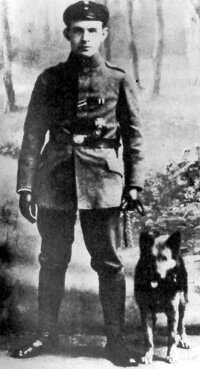 For Erich Remark the war is over too. One week after he was declared fit for service, the war finishes. And then something peculiar happens. When the discharged soldier Remark returns to his parental home, to Osnabrück, he suddenly wears a lieutenants-uniform. On his breast he sports the Iron Crosses First and Second Class.
For Erich Remark the war is over too. One week after he was declared fit for service, the war finishes. And then something peculiar happens. When the discharged soldier Remark returns to his parental home, to Osnabrück, he suddenly wears a lieutenants-uniform. On his breast he sports the Iron Crosses First and Second Class.
Togged up he walks up and down his hometown. He has his photo taken, together with his dear dog Wolf (see this picture on the right). He visits his old comrades. One of them, the one-legged Christian Kranzbühler — yes, the same fellow-soldier he once rescued from No Man's Land — reports him to the military police. He accuses Remark of falsely wearing an officers uniform and not-earned decorations.
Remark is arrested, but he escapes legal action because Germany in this after-war period is in turmoil and chaos. In a police-station he signs a statement wherein he admits that he is not allowed to wear an officers uniform.
He is entitled to the Iron Crosses however, he says in the same statement, "because they were awarded to me by the Soldiers Council. I had to hand in the provisional document in which this is confirmed, to get a definitive charter. This charter I have not received yet."
For these claims no any proof is found, not then, not later — never.
Was Remark suffering from a mental disease? Maybe shell shock, today called Post-Traumatic Stress Disorder?
Books
 Ten years later, in 1929, Erich Maria Remarque publishes Im Westen nichts Neues (All Quiet on the Western Front; picture on the left shows the first English edition), wherein he romanticizes his war experiences. It is an anti-war book of a kind never written before. The circulation is also unheard of — until this moment more than 50 million books are sold, in fifty languages.
Ten years later, in 1929, Erich Maria Remarque publishes Im Westen nichts Neues (All Quiet on the Western Front; picture on the left shows the first English edition), wherein he romanticizes his war experiences. It is an anti-war book of a kind never written before. The circulation is also unheard of — until this moment more than 50 million books are sold, in fifty languages.
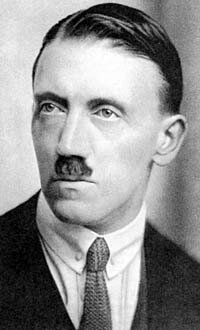 Adolf Hitler (picture on the right) too publishes a book wherein he tells about his war-experiences: Mein Kampf it is called and anyone who reads the two books together fails to see that both are writing about the same war, the same No Man's Land, the same trenches, the same soldiers, the same suffering and death.
Adolf Hitler (picture on the right) too publishes a book wherein he tells about his war-experiences: Mein Kampf it is called and anyone who reads the two books together fails to see that both are writing about the same war, the same No Man's Land, the same trenches, the same soldiers, the same suffering and death.
Where Remarque blames the Kaiser, the generals, the warmongers at home, Hitler knows another cause: the Jews.
There has been said a lot about the content of Mein Kampf. But striking as well is what Hitler did not write in that book. For instance he does not mention the Christmas Truce, where he and his unit were involved in. It happened in those days that the 16th and 17th Bavarian reserve regiments were relieving each other in the frontline near Mesen (Belgium), where you can oversee the valley of the river Douve.
On Christmas morning, right after breakfast, suddenly there were about four hundred soldiers from both sides, brotherly standing together in No Man's Land: soldiers from Bavaria in Germany and from Cheshire and Norfolk in England. First they felt a bit uneasy: Fröhe Weihnachten and Happy Christmas and hands were shaked and some dead were buried that were lying around; everybody helped. Then, suddenly, there was a football, coming from the German line. Some two hundred man ran, as young dogs, behind the ball, without a trace of hostility.
Singing together
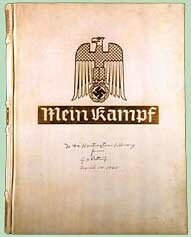 The whole day the men hang around between the two frontlines. "I will never forget this view", the Bavarian soldier Jozef Wenzl, fellow-soldier of Hitler, wrote to his parents: "An Englishman played the mouth-organ of a German pal, others were dancing. Somebody was very proud to put a German pin-helmet on his head. The English sang a song and we sang 'Silent Night'. It was moving: arch-enemies singing together around a Christmas tree."
The whole day the men hang around between the two frontlines. "I will never forget this view", the Bavarian soldier Jozef Wenzl, fellow-soldier of Hitler, wrote to his parents: "An Englishman played the mouth-organ of a German pal, others were dancing. Somebody was very proud to put a German pin-helmet on his head. The English sang a song and we sang 'Silent Night'. It was moving: arch-enemies singing together around a Christmas tree."
Events like this did not fit in Mein Kampf (picture on the left) and in Hitlers way of thinking. Im Westen nichts Neues too did not fit in — and the writer of that book not at all. In 1933, the moment that Germany elects Hitler to power, he opens the hunt for Remarque. In Hitlers eyes his former fellow-soldier has betrayed the Fatherland.
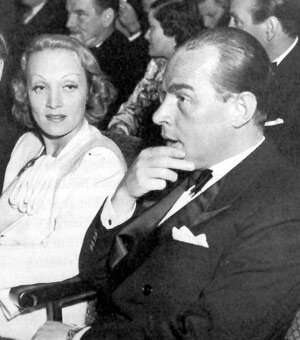 Remarque flees to America. He has already written two sequels to All quiet on the Western Front (The Road Back and Three Comrades) and other novels — and now he becomes even more productive.
Remarque flees to America. He has already written two sequels to All quiet on the Western Front (The Road Back and Three Comrades) and other novels — and now he becomes even more productive.
Hero
In the United States Remarque becomes the hero of the pacifist movement — and of Hollywood, after a movie is made of Im Westen Nichts Neues. He has love-affaires with Marlene Dietrich (picture right), Greta Garbo and Paulette Goddard.
Safe and famous in America nothing can harm Remarque anymore.
That's why the Nazi's in 1943 snatch his sister Elfriede, who had stayed behind in Germany with her husband and two children. After a short trial she is found guilty of 'undermining morality'.
The verdict states verbatim that she is convicted, "as her brother is beyond our reach at this moment".
Elfriede is decapitated with an axe, thus on a specific order by Adolf Hitler.
+++
1) - There has been some confusion about the real name of Remarque. Is it Remark or Kramer?
These are the facts: Erich Paul Remark was born on June 22, 1898 in Osnabrück, son of bookbinder Peter Franz Remark and Anna Maria Stallknecht. His grandfather Peter Aloys Remark was the son of the nailsmith Johann Adam Remarque, born in Aachen on October 28, 1789.
The myth that Remarque's name was 'Kramer', stems from the Nazi's who, embarrassed that a 'German' should have written a book like 'All Quiet on the Western Front', attempted to re-constitute Remarque as a Jew, whose real name was Kramer and who had never been in the war.
Unfortunately, on the occasion of Remarque's death in 1970, dozens of obituaries appeared, many of them still clinging to the legend of Remarque's name being in reality the inversion of 'Kramer'.
2) - Fritz Wiedemann joined the German Nazi party in 1934, becoming Hitler's personal Adjutant, and was frequently sent on unofficial diplomatic missions. In 1939 he came to San Francisco as German Consul-General. After his expulsion to Germany in June 1941, he was appointed German Consul-General in Tientsin (China), holding the post from October of the same year until his arrest by the Americans in 1945. Wiedemann, who had held the rank of SA-Brigadefuhrer since 1935, appeared as a witness at the Nuremberg trials where he was sentenced to 28 months imprisonment.
3) - In May 1940 the Jew Hugo Gutman, on whose recommandation Hitler had received the Iron Cross First Class, lived in Brussels, Belgium. When the Germans attacked the country Guttman, 60 years old, fled via France and Spain to Portugal. From there he sailed, with his family, to the safety of the United States of America.
![]() To the frontpage of The Heritage of the Great War
To the frontpage of The Heritage of the Great War